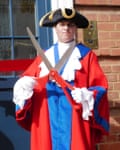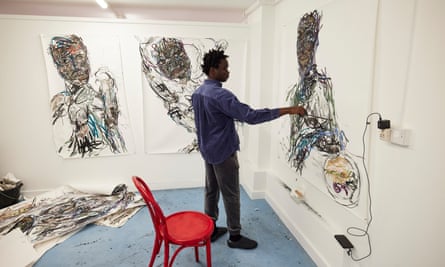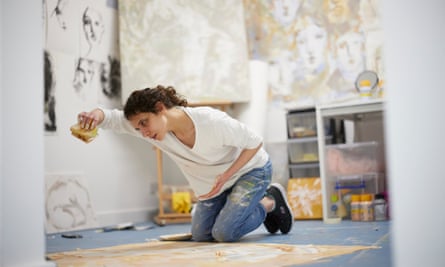It’s a Saturday morning and the band of the 1st Margate Girls’ and Boys’ Brigade is marching down a side street with pipes and drums ringing out amid a crowd that includes luminaries of the art world, Bob Geldof, and the kids across the road who are still in their pyjamas. Then the town’s Social Singing Choir launches into a version of Madonna’s Like a Prayer that is so lovely people cry. Tracey Emin, too, seems to wipe away a tear as she waits in her tricorn hat and red robe – the official costume of a Freewoman of Margate – to cut the red ribbon and officially open her new art school.
This delightful public performance is an Emin artwork, but not as we know it. Emin’s subject matter until now had always been herself. “That woman knows herself,” as Lucian Freud said approvingly. But this ceremony is about her embrace of other people. It’s about the community she is setting out to create.
Emin announced early last year that she was going to open her own art school in Margate, the Kent seaside town where she’s from. Just 15 months later, she is opening the building that houses TEAR (Tracey Emin Artist Residencies), where the first year’s intake of 10 young artists from around the world are already settling in. It also provides affordable work spaces for professional artists, called Tracey Emin Studios.
“I think being an artist is quite lonely”, she tells me a couple of days ahead of the grand opening, settling into the comfy sofa in the common room of her school. “And I don’t have any children. All of these things that other people seem to acquire in life, I don’t have. And when I thought I might die, I thought ‘Fuck, what have I been doing with my life?’ And then I thought: ‘Well, if I get through this, I’m going to do something. I’m going to change things.’”
Emin is now a good halfway, she tells me, to getting the all-clear from the cancer with which she was diagnosed in 2020. “The cancer was really bad, right: there was a good chance I wasn’t going to get through it. And it’s a bit like a promise to myself: ‘What do I need it all for? You cannot take it to heaven, right, you can’t – it’s impossible.’”
We’re sitting inside the promise Emin made to herself. This building, not far from her home, was built as a public baths in the early 20th century: the restored facade has separate entrances marked Men and Women. Now it has become Emin’s idea of an artist community – a place where students and professional artists can encourage and support each other.

“They’re quite brave to come and do it. I mean wow! To Margate. Emmie Nume, for example, who’s never left Uganda before, suddenly arrives here: it’s raining and freezing cold. It was quite a shock to the system. Every week they get two projects they have to do. Already they’ve made a film and they’ve written an essay on Cézanne. They also have to write a poem to read out every Monday.”
I meet the students in their individual work spaces. Nume, from Kampala, is self-taught and paints abstracted portraits with an Auerbach-like intensity. Jorge K Cruz, born in Ecuador and living in Brooklyn, also a painter with no formal training, has pinned up his excellent drawing after Freud’s And the Bridegroom. Bianca Raffaella, a partially sighted painter, is working close up on a painting to add to the ethereally beautiful works covering her walls and floor.
You don’t have to be a painter to study here. Grace Abbott from Brooklyn prefers installation, performance and sculpture. The school is “proper”, says Emin with pride: it has experienced art educator Elissa Cray as director.
“I don’t think they’ve got anything in common,” Emin says of her charges. “That’s one thing I like. They all seemed from their interviews and their work to be able to work alone: two of them have never been to art school for example. But they had to be of postgraduate level even if they hadn’t done a postgraduate course. We asked questions like, ‘What was the last exhibition you saw? Who’s your favourite artist? What book are you reading at the moment?’ And if they didn’t have the answers, then obviously I thought they’re not going to be the right people. If people aren’t willing to educate themselves, what would be the point of them being here?”
It’s the one little flash of Emin’s more acerbic side. But the atmosphere is very happy. The artist Lindsey Mendick, who rents one of the studios, makes me hold a fake arm bone as we look over the multicoloured skulls and maggots that have emerged from her kiln.

“Lindsey and the other artists, we all get on really well,” says Emin. “But they’re all so much younger than me. You know, sometimes I have to go, ‘Fucking hell, no, I’m not doing karaoke.’”
Emin’s institution is her idea of an artist community. Reeling off Margate’s glorious artistic past, she points out that, as well as Turner painting the sea here and Sickert teaching local art classes, Van Gogh walked through when he was a teacher in nearby Ramsgate. Emin’s Studios and Residencies are her answer to Van Gogh’s creative commune, The Yellow House – an ideal of shared artistic living.
“It’s a beautiful way to live and I want to have a beautiful life. And this is so lovely: come here, talk to artists, look at art. Go home, see my cats, paint my pictures. Go to the sea, go for a swim in the ice cold water, come back, dry myself, walk here, look at somebody’s pictures, talk to them about what they’re doing.”
But what makes Emin’s art school different? While TEAR teaches all kinds of art, it places the portrayal of the human figure at the heart of what art is. The corridors are covered with nude drawings the pupils made at the school’s first life class. Emin believes passionately in drawing a naked model. She’s already led her first life class here, and shows me the sensual drawings she did in it.

“There are 20 of us all doing life drawing in the big room upstairs. We had people who just make film or sculpture who were a little bit grumpy about it at first, but then once they got going they were like, ‘Wow, I haven’t done this for 10 years’. It was really lovely and the model was brilliant. It’s about confidence with drawing. It’s like swimming – once you get going, you can really enjoy it: you enjoy looking, you enjoy seeing, and you enjoy slowing down because you’re seeing in a different way. And then after that drawing class, you see everything differently.”
At her own studio a short walk away, Emin has been painting some truly stonking nudes. Her latest paintings are almost mural-scale. I flail to find the words to describe a grand nude whose flesh is subtly coloured in a soft pinky-white.
“The tits are really good,” says Emin.
Seeing how strong her new work is – more energetic than ever, despite her physical challenges – makes me wonder why she wants to teach. Why take on the responsibility of nurturing young artists when she could be in her studio working on her masterpieces?
“Before the cancer I was really unhappy” she says. “I didn’t have anything to lose, did I? So it had to get better. It couldn’t get worse. One good thing that cancer does: when you get through the other side you really appreciate life. You see the whole world differently, and it’s a kind of gift. It sounds corny but it is like being born again really, because you go ‘Whoa, that was dark.’”
After trying the high life with the one per cent, she is finally finding happiness in sharing ordinary stuff. “Like when I bought this furniture, it was so much fun. So much pleasure from just getting an old three-piece suite.

“Most people in life don’t have a choice, they haven’t had it all, they don’t know what it’s like to prance around in the south of France with a Rolex on. Well I’ve done it all, I could do it a million times over, but that isn’t what makes me happy. It isn’t and it never will be.”
The truth, I realise, is that Emin’s altruism and generosity are feeding her creativity. It’s a wonderful reversal of the cliche that great artists have to be selfish. Turner put his mum in Bedlam. Van Gogh’s Yellow House ended with him and Gauguin at daggers drawn. But the more she puts into Margate, the more it gives her back.
“It’s really lovely,” she concludes. “I’m going to get old with this. It’s so much more positive than thinking I’m going to get old and miserable and lonely on my own. I’m not! I’m not! I’m not!”

